最新英语新闻标题及其翻译
- 格式:doc
- 大小:91.50 KB
- 文档页数:13
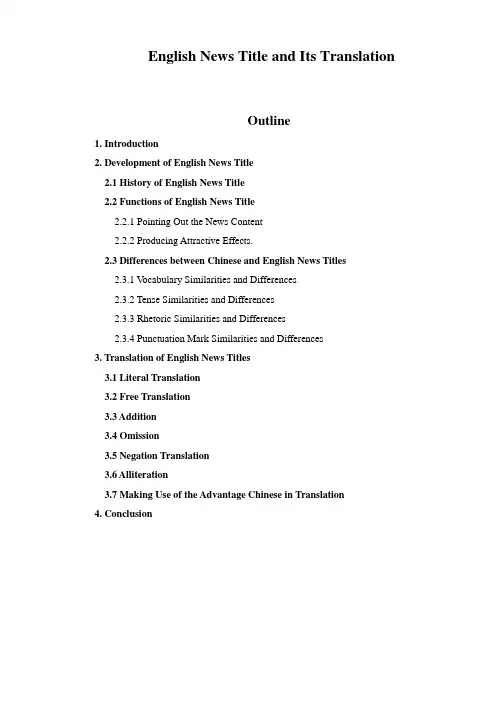
Outline1. Introduction2. Development of English News Title2.1 History of English News Title2.2 Functions of English News Title2.2.1 Pointing Out the News Content2.2.2 Producing Attractive Effects.2.3 Differences between Chinese and English News Titles2.3.1 V ocabulary Similarities and Differences2.3.2 Tense Similarities and Differences2.3.3 Rhetoric Similarities and Differences2.3.4 Punctuation Mark Similarities and Differences3. Translation of English News Titles3.1 Literal Translation3.2 Free Translation3.3 Addition3.4 Omission3.5 Negation Translation3.6 Alliteration3.7 Making Use of the Advantage Chinese in Translation4. Conclusion[Abstract] English news titles play a special role in news reporting. Thus we should place special emphasis on the research of the characteristics and translation of English news titles. This thesis focuses on the study of English news titles in terms of their grammatical features and its translation. When it comes to translation, it tries to reproduce the functions of English news titles which requires translators’ agility and ingenuity in applying semantic and rhetorical devices. With grammatical and semantic exploration into the English news titles, such studies strive to benefit the readers in their understanding of what the editor wants to convey.[Key words] English news title; function; comparison; translations methods英语新闻标题及其翻译[摘要]标题在新闻报道中具有独特的地位。
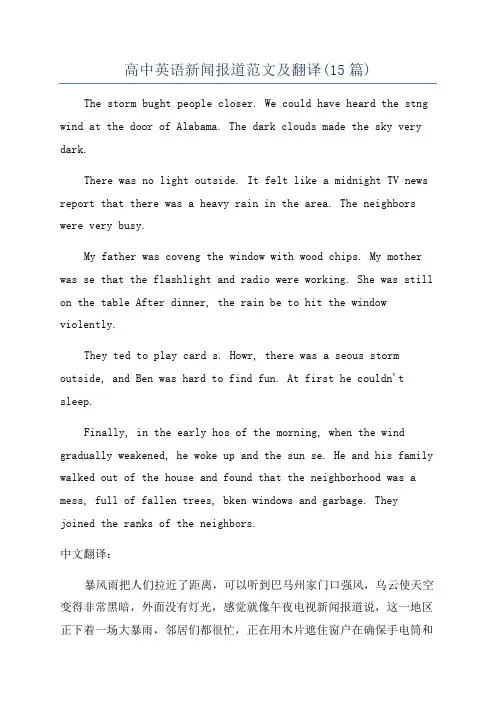
高中英语新闻报道范文及翻译(15篇) The storm bught people closer. We could have heard the stng wind at the door of Alabama. The dark clouds made the sky very dark.There was no light outside. It felt like a midnight TV news report that there was a heavy rain in the area. The neighbors were very busy.My father was coveng the window with wood chips. My mother was se that the flashlight and radio were working. She was still on the table After dinner, the rain be to hit the window violently.They ted to play card s. Howr, there was a seous storm outside, and Ben was hard to find fun. At first he couldn't sleep.Finally, in the early hos of the morning, when the wind gradually weakened, he woke up and the sun se. He and his family walked out of the house and found that the neighborhood was a mess, full of fallen trees, bken windows and garbage. They joined the ranks of the neighbors.中文翻译:暴风雨把人们拉近了距离,可以听到巴马州家门口强风,乌云使天空变得非常黑暗,外面没有灯光,感觉就像午夜电视新闻报道说,这一地区正下着一场大暴雨,邻居们都很忙,正在用木片遮住窗户在确保手电筒和收音机正常工作她还在桌上放了些蜡烛和火柴正在帮做晚饭晚饭晚饭后雨开始猛烈地打在窗户上,他们试图玩纸牌游戏,但是,外面发生了一场严重风暴,很难找到乐趣。

!!2005年6月!!!!!!!!!!!!!!!!!!!!!!!!!外国语言文学研究!June2005第5卷第2期!!ResearchinForeignLanguageandLiterature!Vol.5No.2英语新闻标题修辞赏析与翻译李红霞(北京工业大学,北京,100022)摘要:本文首先讨论了英语新闻标题的修辞特点,并结合大量实例分析各种修辞格在新闻标题中的运用,然后提出了如何翻译英语新闻标题的方法。
关键词:英语新闻;标题;修辞!一、引言当今社会,生活节奏越来越快,人们往往是先预览标题,然后再决定要不要看整篇文章。
标题在新闻中的重要性可见一斑,所以,好的标题一定要能唤起读者阅读的兴趣与愿望,给读者留下清新而深刻的印象。
在一定程度上,标题就是新闻的广告(Leiter,Harriss&Johnson,2003)。
为了突出新闻重点、刺激读者的阅读冲动,记者、编辑不惜努力,使英语新闻标题在词汇、语法、修辞、形式等方面形成了自己鲜明的特色,构成了独特的标题语言(head-linese)(转引自许明武,2003)。
本文收集了近两年来在英美主要报刊发表的一些文章的标题,着重分析其修辞特点,并在此基础上总结英语新闻标题修辞的汉译方法。
二、英语新闻标题修辞特点1.简约新闻标题追求简单明了,一目了然。
在英美报刊上我们常常可以看见单词式标题、短语式标题或短句式标题。
另外,使用简短小词,省略一切无实意的词语,如冠词、介词、连词、系动词等,也是常用的手法。
请看下面这则标题:NEETGeneration(TheGuardian,Nov.2,2004)NEET是noteducation,employmentortraining的首字母缩写,指的是一群“不上学,不工作,也不参加培训的年轻人”。
文章讨论了目前在日本和英国的年轻人中存在的NEET现象,并探讨这种现象的社会源。
首字母缩写不仅使文章标题显得简洁,而且因为是作者新造的词,很容易引起读者的兴趣。
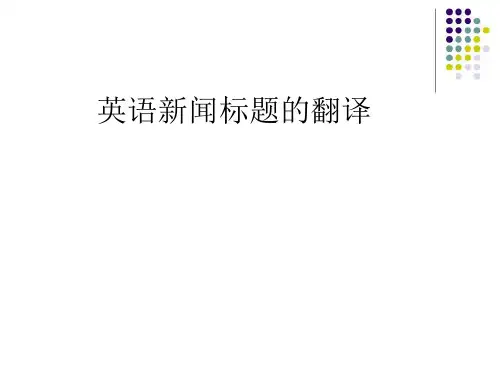
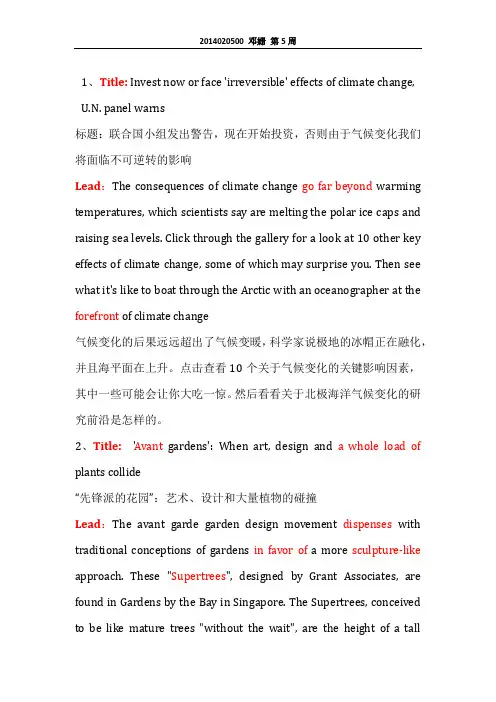
1、Title: Invest now or face 'irreversible' effects of climate change, U.N. panel warns标题:联合国小组发出警告,现在开始投资,否则由于气候变化我们将面临不可逆转的影响Lead:The consequences of climate change go far beyond warming temperatures, which scientists say are melting the polar ice caps and raising sea levels. Click through the gallery for a look at 10 other key effects of climate change, some of which may surprise you. Then see what it's like to boat through the Arctic with an oceanographer at the forefront of climate change气候变化的后果远远超出了气候变暖,科学家说极地的冰帽正在融化,并且海平面在上升。
点击查看10个关于气候变化的关键影响因素,其中一些可能会让你大吃一惊。
然后看看关于北极海洋气候变化的研究前沿是怎样的。
2、Title: 'Avant gardens': When art, design and a whole load of plants collide“先锋派的花园”:艺术、设计和大量植物的碰撞Lead:The avant garde garden design movement dispenses with traditional conceptions of gardens in favor of a more sculpture-like approach. These "Supertrees", designed by Grant Associates, are found in Gardens by the Bay in Singapore. The Supertrees, conceived to be like mature trees "without the wait", are the height of a tallbuilding and support a living "skin" of plants.前卫的园林设计发生变化,实施传统花园理念但更加有利于实现可塑性的方法。
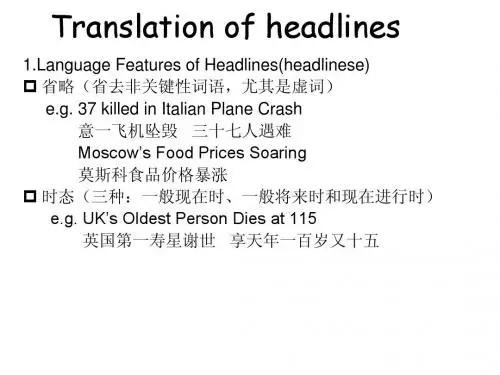

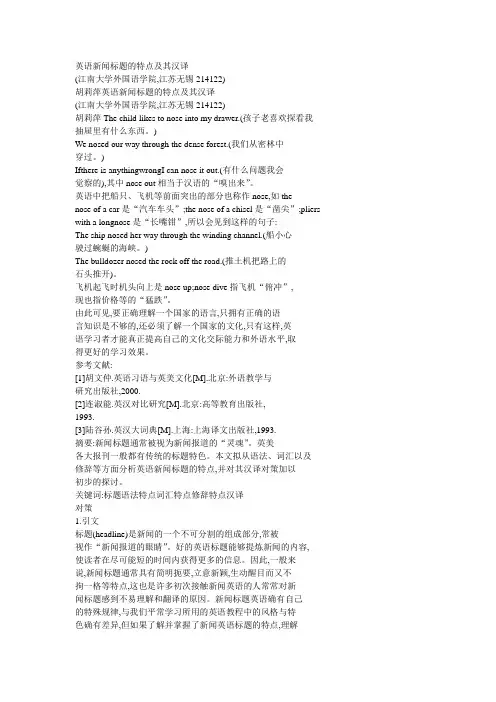
英语新闻标题的特点及其汉译(江南大学外国语学院,江苏无锡214122)胡莉萍英语新闻标题的特点及其汉译(江南大学外国语学院,江苏无锡214122)胡莉萍The child likes to nose into my drawer.(孩子老喜欢探看我抽屉里有什么东西。
)We nosed our way through the dense forest.(我们从密林中穿过。
)Ifthere is anythingwrongI can nose it out.(有什么问题我会觉察的),其中nose out相当于汉语的“嗅出来”。
英语中把船只、飞机等前面突出的部分也称作nose,如thenose of a car是“汽车车头”;the nose of a chisel是“凿尖”;pliers with a longnose是“长嘴钳”,所以会见到这样的句子:The ship nosed her way through the winding channel.(船小心驶过蜿蜒的海峡。
)The bulldozer nosed the rock off the road.(推土机把路上的石头推开)。
飞机起飞时机头向上是nose up;nose dive指飞机“俯冲”,现也指价格等的“猛跌”。
由此可见,要正确理解一个国家的语言,只拥有正确的语言知识是不够的,还必须了解一个国家的文化,只有这样,英语学习者才能真正提高自己的文化交际能力和外语水平,取得更好的学习效果。
参考文献:[1]胡文仲.英语习语与英美文化[M].北京:外语教学与研究出版社,2000.[2]连淑能.英汉对比研究[M].北京:高等教育出版社,1993.[3]陆谷孙.英汉大词典[M].上海:上海译文出版社,1993.摘要:新闻标题通常被视为新闻报道的“灵魂”。
英美各大报刊一般都有传统的标题特色。
本文拟从语法、词汇以及修辞等方面分析英语新闻标题的特点,并对其汉译对策加以初步的探讨。

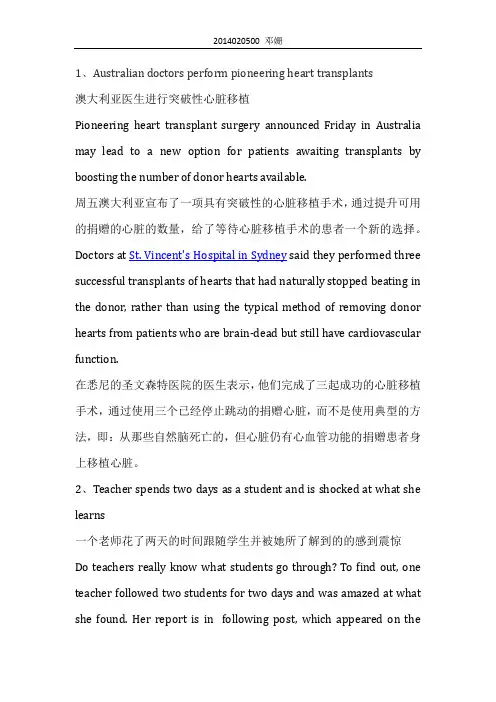
1、Australian doctors perform pioneering heart transplants澳大利亚医生进行突破性心脏移植Pioneering heart transplant surgery announced Friday in Australia may lead to a new option for patients awaiting transplants by boosting the number of donor hearts available.周五澳大利亚宣布了一项具有突破性的心脏移植手术,通过提升可用的捐赠的心脏的数量,给了等待心脏移植手术的患者一个新的选择。
Doctors at St. Vincent's Hospital in Sydney said they performed three successful transplants of hearts that had naturally stopped beating in the donor, rather than using the typical method of removing donor hearts from patients who are brain-dead but still have cardiovascular function.在悉尼的圣文森特医院的医生表示,他们完成了三起成功的心脏移植手术,通过使用三个已经停止跳动的捐赠心脏,而不是使用典型的方法,即:从那些自然脑死亡的,但心脏仍有心血管功能的捐赠患者身上移植心脏。
2、Teacher spends two days as a student and is shocked at what she learns一个老师花了两天的时间跟随学生并被她所了解到的的感到震惊Do teachers really know what students go through? To find out, one teacher followed two students for two days and was amazed at what she found. Her report is in following post, which appeared on theblog of Grant Wiggins, the co-author of “Understanding by Design” and the author of “Educative Assessment” and numerous articles on education. A high school teacher for 14 years, he is now the president of Authentic Education, in Hopewell, New Jersey, which provides professional development and other services to schools aimed at improving student learning. You can read more about him and his work at the AE site.老师真的知道学生经历了什么吗?为了找到答案,一个老师跟随了两个学生两天,被自己所发现的惊讶了。
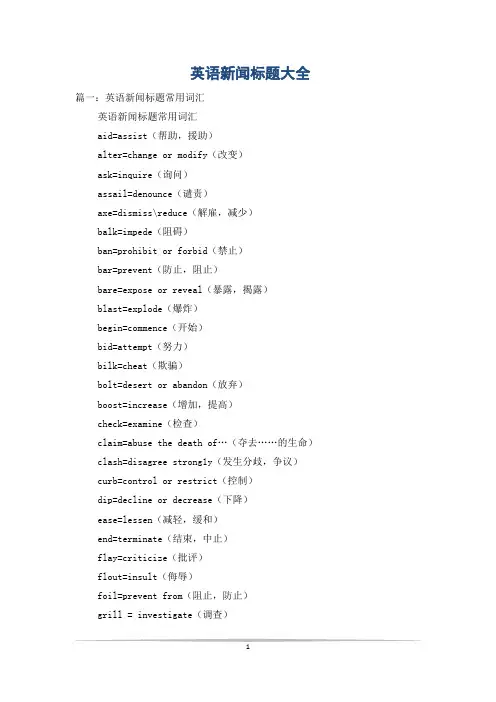
英语新闻标题大全篇一:英语新闻标题常用词汇英语新闻标题常用词汇aid=assist(帮助,援助)alter=change or modify(改变)ask=inquire(询问)assail=denounce(谴责)axe=dismiss\reduce(解雇,减少)balk=impede(阻碍)ban=prohibit or forbid(禁止)bar=prevent(防止,阻止)bare=expose or reveal(暴露,揭露)blast=explode(爆炸)begin=commence(开始)bid=attempt(努力)bilk=cheat(欺骗)bolt=desert or abandon(放弃)boost=increase(增加,提高)check=examine(检查)claim=abuse the death of…(夺去……的生命) clash=disagree strong1y(发生分歧,争议)curb=control or restrict(控制)dip=decline or decrease(下降)ease=lessen(减轻,缓和)end=terminate(结束,中止)flay=criticize(批评)flout=insult(侮辱)foil=prevent from(阻止,防止)grill = investigate(调查)gut=destroy(摧毁)head=direct(率领)hold=arrest(逮捕)laud=praise(赞扬)lop=diminish(下降,减少)map=work out(制订)mark=celebrate(庆祝)name=appoint\nominate(命名,提名) moot=discuss(讨论)mull=consider(考虑)nab=arrest(逮捕)nip=defeat(击败)nix=deny\disapprove(否决,拒绝)opt=choose(选择)oust=expel(驱逐)peril=endanger(危害,危及)pledge=determine(发誓)plot=conspire(预谋,密谋策划)plunge=plummet(价格等)暴跌poise=ready for action(作好准备) probe=investigate(调查)raid =attack(进攻)rap =criticize(批评)rebuke=criticize(批评)rout=defeat completely(击溃,打垮) slay=murder(谋杀)soar=skyrocket(急剧上升)spur=encourage(激励,鞭策)swap=exchange(交流,交换)sway=influence(影响)trim=reduce(削减)vie=compete(竞争)vow=determine(决心,发誓)weigh=consider(考虑)woo=seek to win(争取,追求)常见诸报端的标题小词,以备不时之需:ace=champion(得胜者)aid=assistance(帮助)blast=explosion(爆炸)body=committee,commission (委员会)clash=controversy(机构)crash=collision(碰撞,坠毁)deal=agreement,transaction (协议,交易)dems=democrats(民主主义者,民主人士,民主党党员)envoy=ambassador(大使)fake=counterfeit(赝品,骗局)fete=celebration(庆祝)feud=strong dispute(严重分歧)flop=failure(失败)freeze=stabilization (冻结,平抑)glut=oversupply(供过于求)GOP=Grand 0ld Party(〈美国〉共和党)nod=approval(许可,批准)pact=agreement,treaty (条约,协议)poll=election,public opinion poll (投票选举,民意测验) probe=investigation(调查)pullout=withdrawal(撤退,撤离)rift=separation(隔离,分离)row=quarrel(争论,争议)set=ready(准备)snag=unexpected difficulty (意外障碍,意外困难)statement=dispute that cannot be settled(僵持,僵局) stance=attitude(态度)step=progress(进程,进步)strife=conflict(冲突,矛盾)ties=(diplomatic)relations (关系)一些常见诸英语报端的这类节缩词,供读者读报时对照、查考: Aussie=Australian(澳大利亚的)biz=business(商业)champ=champion(冠军)con=convict(罪犯)deli=delicatessen(熟食)expo=exposition(博览会)homo=homosexual(同性恋)lib=liberation(解放)pro=professional(专业的,职业的)rep=representative(代表)Russ=Russia(俄罗斯)Sec=secretary(秘书)chute=parachute(降落伞)copter=helicopter(直升机)nat’l=national(全国的)com’l=commercial(商业的,广告)c’tee=committee(委员会)C’wealth=Commonwealth(英联邦)telly=television(电视机)tech=technology(技术)pix=pictures(电影)vet=veteran(老兵,老手)vic=victory(胜利英语新闻标题中经常出现的缩写词主要分为三类:1、组织机构等专有名称,如上述例句中的CPPCC (全国政协)和PLO(巴解组织)。
英文新闻标题的汉译方法6篇第1篇示例:英文新闻标题的汉译方法在阅读英文新闻时,经常会遇到需要将英文标题翻译成汉语的情况。
正确翻译标题对于理解新闻的主题和要点非常重要。
下面将介绍一些关于英文新闻标题的汉译方法,希望对大家有所帮助。
1. 直译法直译法是最简单的一种翻译方法,即将英文标题逐字逐句地翻译成汉语。
这种方法适用于一些简单的标题,尤其是涉及到具体名词或术语的标题。
例如:英文标题:China's Economic Growth Continues to Accelerate直译法:中国的经济增长持续加速在直译法中,需要注意保持原文的句子结构和逻辑顺序,尽量避免对原文内容进行太多的增减或解释。
意译法是将英文标题的含义和精神翻译出来的方法,通常会对原文的表达方式进行调整以适应汉语的语境和习惯。
这种方法适用于一些含义比较抽象或者难以直译的标题。
例如:3. 拆词法在拆词法中,需要注意保持原文单词和短语的搭配和语义关系,避免对原文内容进行混淆或失真。
正确翻译英文新闻标题对于理解新闻内容非常重要。
在选择翻译方法时,可以根据标题的具体内容和表达方式来灵活运用直译法、意译法和拆词法等不同的方法,以确保翻译的准确性和流畅性。
希望以上介绍的关于英文新闻标题的汉译方法对大家有所帮助。
第2篇示例:英文新闻标题的汉译方法在翻译界被称为头条翻译,是一种要求精准、简洁、有力的翻译技巧。
头条翻译是新闻编辑、翻译人员在翻译新闻标题时采用的一种快速、直接、传神的翻译方式,旨在让读者在第一时间读懂新闻的主要内容。
好的头条翻译不仅能够准确传达原文的意思,还要具有一定的吸引力,能够吸引读者的眼球,引起读者的兴趣。
头条翻译的要点有几个:精准、简洁、有力。
首先要做到精准,即准确表达原文的含义,避免歧义和误解。
其次是简洁,要尽量保持简洁,避免冗长繁复的表达,力求用最简单明了的语言表达出新闻标题的核心内容。
最后是有力,要用生动形象的语言,有力度地表达出新闻的重要信息,吸引读者的眼球。
2014020500 邓姗第8周1、Title: Death and the goddess: The world's biggest ritual slaughter标题:死亡和女神:世界最大的祭祀仪式Lead:Thousands of water buffalo and goats will be slaughtered in Nepal's Gadhimai festival.Held every five years, the festival is dedicated to a Hindu goddess of power.Animal rights activists have campaigned to change attitudes and reduce the killing.标题:在尼泊尔的嘉蒂麦女神节,会有成千上万的水牛和山羊被屠宰。
这个每五年举行一次的节日,是向印度教中力量女神致敬。
动物权益保护主义人士要求他们改变思想并且减少杀害。
Paragraph:Motilal Kushwaha had promised the Hindu goddess Gadhimai that he would offer her a male goat if one of his children found a job.Last year his son was successful -- and on Saturday he was one of tens of thousands of people killing the animals at the temple of Gadhimai in southern Nepal as part of the biggest religious mass slaughter in the world."From my village everyone has made a vow [to offer animals]," says Kushwaha from Bariyarpur, a community in Bara district about 60miles south of Kathmandu. Some, he explains, are glad they have got a son or a daughter, others that a different form of good fortune has befallen them.The ritual sacrifice of goats, buffaloes and roosters in temples and at home is widespread in Nepal where 80 percent of the population are Hindu.Some five million people from adjoining districts -- and also from the bordering Indian states of Bihar and Uttar Pradesh -- will attend the festival, according to local authorities, although only two days are dedicated to the sacrificial ritual itself.Motilal Kushwaha 向印度女神嘉蒂麦承诺,如果他其中一个孩子找到工作就会向女神进献一只公山羊。
本科生毕业论文设计中英新闻标题翻译作者姓名:王群指导教师:杨丽华所在学部:外语学部专业:英语班级(届):2009届3班二〇一三年四月二十二On the Translation of Chinese and English News HeadlinesByWang QunSupervisor Prof. Yang LihuaA ThesisSubmitted to the Foreign LanguagesSchoolIn Partial Fulfillment of the RequirementsFor the Degree of Bachelor of ArtsAt Hebei Normal UniversityContentsAbstract (English) (ii)Abstract (Chinese)............................................................................................. iii Introduction (1)Chapter 1 Brief Introduction of English News Headlines (3)1.1 Definition of English News Headlines (3)1.2 Functions of English News Headlines (4)1.3 Features of English News Headlines (6)Chapter 2 Comparison Between Chinese and English News Headlines (10)2.1 Differences between Chinese and English News Headlines (10)2.2 Similarities between Chinese and English News headlines (15)Chapter 3 Translation of English News Headlines (16)3.1 Difficulties of English News Headlines Translation (16)3.2 A Brief Review on Translation Criteria (17)3.3 Criteria of English News Headlines Translation (18)3.4 Strategies and Tactics of English News Headlines Translation (20)Conclusion (2)5 Bibliography (26)AbstractWith deepening of the reform and opening up policy and entry into the WTO ,the Chinese are eager to know the world. A large number of information is transmitted by news media especially news reports.The essential part of news report is headline. Sometimes people don‘t have enough time to read the whole news from the beginning to the end, most readers would like to know as much as they can in the shortest time. Therefore , it can be concluded that the headline plays a very important role on news reporting, and we must pay more attention to the translation of news headline.This paper mainly introduces some translating skills according to the features of English news headlines. There are three parts in this paper. In chapter one, it introduces the definition, function, classification and features of English news headline. In chapter two, it introduces the differences and similarities between English and Chinese news headlines. The problems appeared in English news headline translation are introduced in the last chapter. In the end of this paper, it has a conclusion of the content .To sum up, this paper hopes to find a appropriate way of English news headline translation by discussing of the features, functions and the criteria of English news headline translation.Key words: journalistic English; headlines; features; criteria; translationtactics摘要随着改革开放的进一步深化以及中国加入世界贸易组织,中国与西方国家的交流与联系也越来越频繁。
Outline1. Introduction2. Development of English News Title2.1 History of English News Title2.2 Functions of English News Title2.2.1 Pointing Out the News Content2.2.2 Producing Attractive Effects.2.3 Differences between Chinese and English News Titles2.3.1 V ocabulary Similarities and Differences2.3.2 Tense Similarities and Differences2.3.3 Rhetoric Similarities and Differences2.3.4 Punctuation Mark Similarities and Differences3. Translation of English News Titles3.1 Literal Translation3.2 Free Translation3.3 Addition3.4 Omission3.5 Negation Translation3.6 Alliteration3.7 Making Use of the Advantage Chinese in Translation4. Conclusion[Abstract] English news titles play a special role in news reporting. Thus we should place special emphasis on the research of the characteristics and translation of English news titles. This thesis focuses on the study of English news titles in terms of their grammatical features and its translation. When it comes to translation, it tries to reproduce the functions of English news titles which requires translators’ agility and ingenuity in applying semantic and rhetorical devices. With grammatical and semantic exploration into the English news titles, such studies strive to benefit the readers in their understanding of what the editor wants to convey.[Key words] English news title; function; comparison; translations methods英语新闻标题及其翻译[摘要]标题在新闻报道中具有独特的地位。
英语作文新闻报道范文及翻译看新闻报道,了解社会,看英语版本,提高自己的英语阅读能力。
下面是店铺给大家整理的英语作文新闻报道范文及翻译,供大家参阅! 英语作文新闻报道范文及翻译:铁路旅客手指被夹自动门不得不跟随高铁列车一起跑Video footage shows a man forced to run alongside amoving high speed train after getting his fingerclamped between one of the doors.视频显示一名男子手指被夹自动门,不得不跟随高铁列车跑起来。
The video was filmed on May 15 at a station inChangzhou, east China's Jiangsu province, accordingto the People's Daily Online.视频拍摄于5月15号江苏常州站,人民网报道。
After some time, the man manages to pull his fingeraway from the closed doors.一会之后,这名男子成功的将手指挣脱开来。
In the footage the man can be seen moving along with the train.从视频中可以看出男子和列车一起跑了起来。
According to Xinmin, the man boarded the wrong train thinking it was the G7080 train.据称男子上错车,以为那是G7080列车。
As soon as he realised his mistake, he tried to exit the train.意识到自己上错车后,他立马走出车门。
However as he left in a hurry, he got a finger on his left hand trapped in the automatic doors.然而在他匆忙下车时,他左手手指被夹在了自动门里。
Outline1. Introduction2. Development of English News Title2.1 History of English News Title2.2 Functions of English News Title2.2.1 Pointing Out the News Content2.2.2 Producing Attractive Effects.2.3 Differences between Chinese and English News Titles2.3.1 V ocabulary Similarities and Differences2.3.2 Tense Similarities and Differences2.3.3 Rhetoric Similarities and Differences2.3.4 Punctuation Mark Similarities and Differences3. Translation of English News Titles3.1 Literal Translation3.2 Free Translation3.3 Addition3.4 Omission3.5 Negation Translation3.6 Alliteration3.7 Making Use of the Advantage Chinese in Translation4. Conclusion[Abstract] English news titles play a special role in news reporting. Thus we should place special emphasis on the research of the characteristics and translation of English news titles. This thesis focuses on the study of English news titles in terms of their grammatical features and its translation. When it comes to translation, it tries to reproduce the functions of English news titles which requires translators’ agility and ingenuity in applying semantic and rhetorical devices. With grammatical and semantic exploration into the English news titles, such studies strive to benefit the readers in their understanding of what the editor wants to convey.[Key words] English news title; function; comparison; translations methods英语新闻标题及其翻译[摘要]标题在新闻报道中具有独特的地位。
因此在整个新闻英语翻译中标题翻译的作用不可忽视。
本文拟从以下角度进行论证:英文报刊标题的文字简练醒目,无疑是来源于对英语语法得心应手的灵活运用。
而要再现英文标题在原文中所起的浓缩主题、画龙点睛的作用,需要译者同样在用词和修辞等语法方面匠心独运。
本文拟通过对英语新闻标题翻译原则和策略的探讨,以期能对新闻英语包括英语标题翻译找到一条具有特定翻译规则的途径作出有益的尝试。
[关键词] 英语新闻标题; 作用; 分类; 对比; 翻译方法1 IntroductionWhat is the title? A title of a piece of news usually printed in large type and devised to summarize, gives essential information, or interests readers in reading the news content . Naturally readers buy newspapers in order to keep posted on daily happenings. However, t oday’s English newspapers are getting fatter with a greatnumber of pages. Therefore, many readers have formed the habit of scanning titles, which makes possible rapid news comprehension. Thus one of the most important purposes of titles is to inform readers quickly, which means that a well-designed title immediately tells them the gist of the accompanying story. Nothing is more important than packaging the product. A piece of news and its titles resemble the product and the packaging respectively. Only when the titles grasp the attention of the readers, the whole page can obtain vitality. So we say a final requirement of titles is to stimulate the reader’s artistic sense.Therefore, news people need to make sure that English title forms are set to beautify the layout of the newspaper and thus to interest readers in the stories.2. Development of English News Title2.1 History of English News TitleThe history of English news title is long and it can be divided into three phases. English news titles were originated in the Qing Dynasty. The characteristic of embryo is long and complex. The second stage of news title begins with the characteristic of diversity in the 19th century 70's. The third stage is from 20th century to nowadays and has the feature of concise and simplicity. In a word, the translation of English news title experienced the process from complexity to simplicity.2.2 Functions of English News TitleThe news title is the fundament al part of any piece of news. In a time when it’s harder to get people’s attention, good writers always spend too much time and creative energy working on their titles, because they know that the title is one of the most important parts of their work. According to Bruce H. Westley, from the standpoint of the reader, newspaper titles serve the following purposes:2.2.1 Pointing Out the News ContentNews titles summarize the news content, so the news content can be reflected by the titles alone. By glancing over them, the readers will know what the story is about. Readers can quickly locate the parts that interest him mostly by following the sequence of the news points line by line. Titles rank the importance of stories by the size of the print and placement on the page. And titles can convey the relative significance of the news.2.2.2 Producing Attractive EffectsNews titles are essential to attract the re ader’s attention. General speaking, two methods are used. First, the consistent use of familiar title structure gives the newspaper a relatively familiar and welcome nature. Secondly, English news title is trying to make good use of the front page of a newspaper, especially in electronic media. All of that can help attract the public’s attention. The front page plays the most important role of attracting the eyeballs of the readers well. Since newspapers are usually sold on the newsstands with just the top-half of the paper showing to the passengers, reporters of newspapers try every means to make the banner titles across the top of the page attractive enough to be a crowd-stopper (Westley 1972).2.3 Differences between Chinese and English News TitlesUnderstanding the similarities and differences between the Chinese and English news titles are carrying on the accurate translation. Any thing has its general character and its individuality. The Chinese and English news title is not exceptional. Directness and factuality are the two most prominent general characters. But the different language cultural context and the news tradition enable the Chinese and English title to have their own clear characteristics.2.3.1 Vocabulary Similarities and DifferencesIn most cases both English titles and Chinese titles share similarities in the vocabulary usage. First, in the news titles they both use shrinks and concise words (In Chinese we often used “armed police”,“Political Consultative Conference”,“WTO”,“Security Council”and so on. In English UN, UK, USA, NATO, WTO, NASA EU) “Minor term” is the popular word usage and t he fashionable word usage in English news titles. Second, both enjoy using popular words. Third, both enjoy using stylish words. For example:(1) 全球瞩目A股巨震,暴跌难阻股民入市热情(2) MP demands probe into MoD bungles (MP=Member of Parliament; MoD=ministry ofDefense(3) 越来越多的人在聚会时喜欢“k歌”(K song is stylish word)(4) American Online; Often Down, Never Out (Online is stylish word)The first two examples use the popular terms and the last two ones use the stylishword.Differences:Judging from vocabulary, the Chinese news title is fond of using several verbs together, but the English news title is fond of using several noun words together. English news often uses short words and some initials or acronyms which are printed in large type, Such as EEC short for European Economic Community.(5) 开放搞活改革致富(6) Britain “Flagship” Detention Center Abandoned(7) 武船再助“神舟”飞天(“武船”指武昌造船厂)(8) A 2nd LI Priest Removed (LI=Long Island)The first example shows Chinese title uses four verbs together, while the second one shows English title uses four nouns together. That’s the difference lying in the Chinese and English news title in the vocabulary usage.2.3.2 Tense Similarities and DifferencesEnglish and Chinese news titles all massively use the phrase title. In Chinese we commonly use verb-object phrase, noun phrase and so on. In English we commonly use non-localization minor sentence (for example participial phrase, Infinitive phrase and gerund phrase), adjective phrase, and preposition phrase and so on. Translation may happen according to respective characteristic transformation. E.g.(9) Five Ways to Be Romantic(10) Helping the Homeless to Help Themselves(11) US carmakers ready to cut output.(12) 走向美好明天的江西.(13) 变化中的股市(14) 中国与发展In the above English news titles, the first uses the infinitive phrase, the second uses the gerund phrase and the third uses the adjective phrase. In the Chinese news titles, the first uses two verb-object, the last one uses noun -verb.When we read English news title we will find English news titles often use simple present tense, present progressive tense and simple future tense, whose sign is obvious. However, you will find Chinese news titles often use present tense and progressivetense. Who tense sign is not obvious (Peter, Newmark 2001).For example:(15) French Culture Is the Doldrums法国文化颓然不振(16) China is growing strong.中国正在发展壮大.(17) China had an earth-shaking change.中国发生了一个翻天覆地的变化(18) 中国自然资源丰富.(19) 总理会见了受难群众(20) 中国法律将更加完善.(21) 圆满取得了成功.From the above examples we can find the first four examples use general present tense, general future tense, and present progressive tense, general past tense individually, and have obvious tense signs. The last ones use general present tense, the present tense replace past tense, future tense, past tense. But they have no obvious tense signs.2.3.3 Rhetoric Similarities and DifferencesBoth English and Chinese news title use the ordinary rhetoric, such as metaphor and hyperbole. It can attract more readers and make the news more clear and colorful.(22) Dam work brings flood of debate(23) 孩子是祖国的花朵(24) Graying Armies March to Defend Social Security(25) 一落千丈The first and second examples use the metaphor. The rest uses the hyperbole. The above two kinds of rhetoric are often used in English and Chinese news titles.As for the rhetoric, English-Chinese news title style is respectively different. The Chinese news title highly values a literary talent especial in antithesis and controls rhyme. The English news title is insipid and pays more attention to the fact. The usage of rhetoric lattice is limited. It often uses literary quotation, allegory, personification, harmonic tone, alliteration, repetition, word or phrase with double meaning, changing the order of rhetoric. Chinese news titles often use parallelism, overlapping, swing, aphorism, antithesis, comparison, word or phrase with double meanings. Some rhetoricis respectively for English institute such as alliteration and swings.(26) Protestant Protest(27) Grammy Apple of New York’s Eye?(28) The Scent of Descent(29) 名言草,实言人。